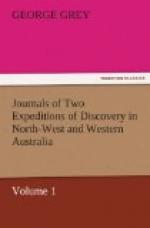The 13th we spent in passing a portion of the Darling Range. After travelling for eleven miles over a hilly country we came upon a beautiful valley between two steep and high hills. Two streams poured down into this valley and there formed a small freshwater lake. The scenery here was so green and verdant, the tranquil little lake was so covered with broad-leaved waterlilies, and the whole wore such an air of highland mountain scenery that I could readily have imagined I was once more in Scotland. About this lake there was also much good feed.
CROSS THE DARLING RANGE.
In the course of the afternoon we travelled eight miles further in an easterly direction, and were then obliged to halt without water, which we did not again succeed in finding after we left the lake.
TO THE HOTHAM RIVER.
On the morning of the 14th we had only travelled six miles in a due easterly direction when I found we had crossed the Darling Range; our course now lay along a level fertile plain, well fitted for pastoral purposes. We travelled across this a distance of about five miles when we came upon the river Bannister, which here was nothing but a series of large pools with good feed for cattle about them. We halted for breakfast and afterwards continued in an easterly direction, when, after travelling for another six miles, we reached the Hotham. The land we passed over between the Bannister and Hotham was equal in goodness to any I have seen in Western Australia.
The circumstance of both water and feed abounding at the Hotham induced me to halt here for the night, and on the morning of the 15th we commenced our toilsome march from the Hotham to the Williams; the distance is about twenty-eight miles in a direct line; the country consisting of rocky hills, difficult to cross; and throughout the whole of this distance we could find no water: we were thus for eleven hours exposed to the sun in one of the hottest days I have ever felt, and we were not a little glad when just at sunset we found ourselves on the banks of the Williams.
CONDITION OF DISTANT SETTLERS.
We here found the establishment of an out-settler, of which it would be difficult to convey an adequate idea: the house consisted of a few upright poles, one end of each resting on the ground, whilst the other met a transverse pole, to which they were tied; cross-poles then ran along these, and to complete the building a sort of rude thatch was tied on it. It was open at both ends and exposed to the land wind, which, as the situation was high, I found a very unpleasant visitor during the night. Here we found a very large flock of sheep in fair condition, also a well-supplied stockyard, and cattle in beautiful order; upwards of twenty kangaroo dogs completed the establishment.
These settlers were, at the time I visited the Williams, four in number; consisting of one young man, two youths, and a little boy. Four soldiers were quartered about sixteen miles from them, and there was no other European within fifty miles of the spot. The distance they had to send for all stores and necessaries was one hundred and twenty miles, and this through a country untraversed by roads and where they were exposed to the hostility of the natives in the event of any ill-feeling arising on their part.




